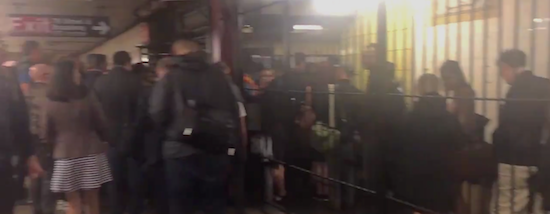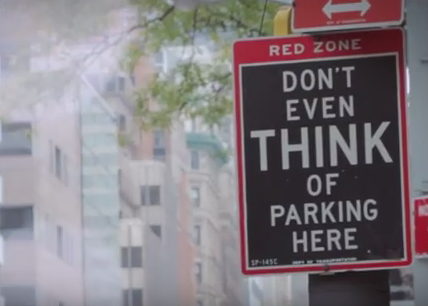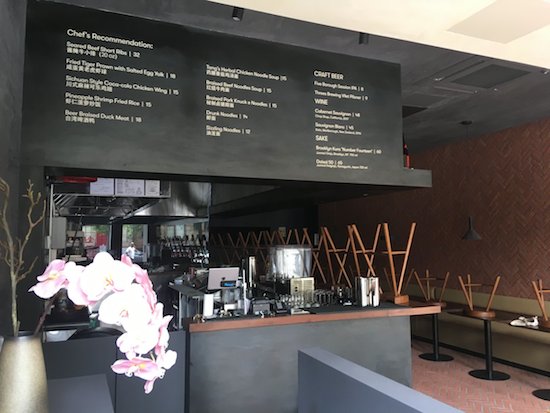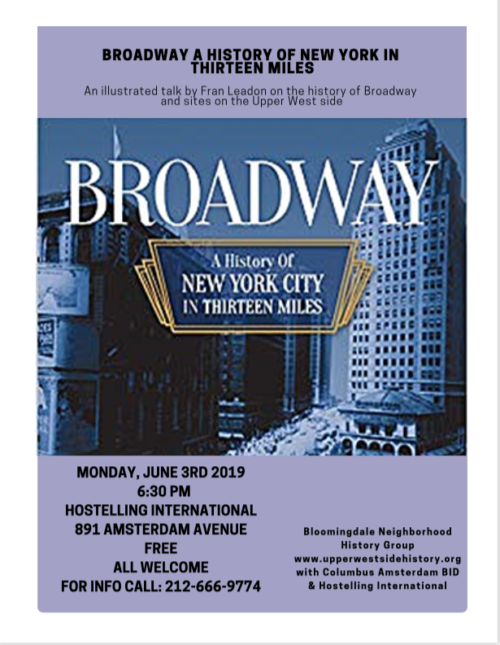
The lines to get out of the station.
The 79th Street subway station on the 1 line has been extremely overcrowded in recent days, particularly at rush hour, as hundreds of people file toward one narrow exit. As many as five train-loads of people have been stuck on the platform as the line slowly files out, according to people who use the station.
https://twitter.com/Isebrand/status/1133858551343005696
This is the line to exit the 79th street 1 train station, @NYCTSubway. #wethecommuters pic.twitter.com/VKmzchpsPs
— Kate Hinds (@katehinds) May 13, 2019
🎶 New York, I love you, but you’re bringing me down. 🎶 pic.twitter.com/Ag3dy9P1Ii
— Amara Grautski (@AmaraGrautski) May 30, 2019
Another exit at the station has been closed for weeks due to construction and now that construction project “has been complicated by the discovery, after wall tile removal, of extensive structural steel corrosion that must be repaired,” MTA spokesman Shams Tarek told Gothamist on Thursday. “”To help manage crowding, we’re deploying additional station personnel every weekday from 4 to 8 p.m. starting today, and are continuing to monitor the morning rush as well.”









They should close the station. It’s a major liability.
Even with all the exits working, this station is unsafe – people often have to wait by the stairs to exit. If there is a scare similar to what happened on the 96-th street a little while ago – situation would be dire. 86-th street station is not much better.
This is incredibly dangerous and happens at more stations than just the 79th Street 1 Station. Not only should the MTA reopen the additional exit as quickly as possible, they should have long ago revamped the entire entry and exit system to be more efficient and safe.
“Deploying MTA personnel” translates to having someone stand with a flashlight and shine it in your eyes while calling out commands and being generally unhelpful.
I assume I’m not the only one who has been in this situation and contemplated the disaster and stampede that would ensue if a fire started or someone had a weapon. Both of which, sadly, aren’t exactly out of the realm of possibility here in NYC.
In fairness the MTA employees yesterday were preventing people from coming down the stairs while my train was leaving / going up the stairs.
Normally you’re 100% right that they do nothing but bark commands, but in this case they were being semi useful in stopping the people salmoning down the stairs while hundreds were leaving, which increased throughput for sure
“salmoning down the stairs”? that’s an interesting use of language i’ve never heard.
does it mean “weaving”? i would think “salmoning” would more often be used to describe going UP the stairs.
I’m not being sarcastic here. it was na interesting usage on Brian’s part.
I’m sure a lot of people have been wondering what the hecht “salmoning” meant…
(Pescally speaking…)
It might have been his computer’s “correcting” a perceived misspelling if he actually intended to write “slaloming” which, if so intended, also might have been a novel use of language.
This salmoning conversation is riveting.
I believe Brian was using “salmoning” to suggest salmon swimming upstream, i.e., going against the current. In the case of the 79th Street station, people entering during rush hour are moving against the much larger current of people trying to exit.
Not to mention the MTA probably could have looked at adding an additional street access at 80th Street on the Uptown side when the residential building was being built on that SE corner over the last few years and could of asked the building developer to offset the cost. They dug down below street level for a parking garage there so an additional exit could have been easily been a possibility…
Why would the developer want to include a subway exit in his building? And why would he want to offset the cost? Developers don’t just do these things; they need an incentive to spend their private money on a public project.
at Conor, you’re absolutely correct! Similar to what was done when The Boulevard (West 86 street) was built in the mid-80s. They added another method of egress.
Re: “They added another method of egress.”
Fortunately, UWSers are now a lot smarter than 19th Century NYers who, after paying to enter “Barnum’s American Museum”, were fooled by the word “Egress”:
According to Wikipedia: “Barnum noticed that people were lingering too long at his exhibits. He posted signs indicating “This Way to the Egress”….”
and befuddled patrons then found themselves outside the building, having to pay a second fee to re-enter.
If find that all rather egregious…
I walk by the stairwell at street-level regularly. It’s been boarded up for months, not weeks. Much of the sidewalk is taken up by the boarding.
I never understand why the city takes months to fix stairwells and escalators (see the Columbus Circle subway escalator on the NW corner of 58th & Bway- MONTHS). Meantime, the private company erecting the tall building at 69th & Amsterdam has added several floors during the time this stairwell has been closed. One stairwell vs several floors of a building. Something is wrong.
In construction the longest part is with the underground foundation work. After that they can start adding a new floor each week.
I have to tell you? In one word “unions”, coupled with archaic work rules along with government (federal and local) interference.
Anything that the private sector can do rather quickly and easily takes ages longer when city or state perform a similar project.
The MTA/NYCT is notorious for spending far more than it should, going over budget and taking ages to finish things. That hot mess known as East Side Access for LIRR into GCT is a case in point.
B.B., you’re exactly right. I once worked as an engineer in a union run factory and naively asked a guy why his counterpart was so much more productive than he was. His answer sums up most unionized jobs. He said “I get paid the same no matter how fast I work.” There are no carrots and miniscule sticks, metaphorically speaking, resulting in a grossly unproductive workforce.
B.B, I’m not surprised that you hate unions.
You’re that real estate guy, right?
You must be a union steward, by that logic.
It’s actually quite simple, and unsurprising: It’s private companies vs. government.
Private companies always get similar and/or bigger projects done much faster, and much cheaper. It’s because they have an incentive, they have deadlines to meet, caps to fill, profits to make. They have that motivation to produce in the most efficient way, at the most efficient rate. Government, however, does not have that same incentive. They are universally less effective, much more expensive, and a lot slower, on top of the fact that they often spend a lot of money on gratuitous extra stuff no one asked for (See Fulton Center and OMNY, the new cashless system they’re starting to roll out. Fulton Center cost $1.5B, and OMNY will cost almost $600M). On top of that, with the MTA’s lack of inspection and oversight, retrofit projects are bound to be far longer than advertised, as they are surely going to find more structural defects than they prepare for (The 28th Street Station on the 6 train is a prime example of this.)
Upon the arrival of Uber, Lyft, Via, the MTA started to become aware of this reality, and responded in the worst way possible, by attempting to stifle these companies, with congestion pricing, which should’ve been the last step in their revitalization process, not close to the beginning. Congestion pricing tries to fund the MTA, but in doing so, it also forces more people onto the cash-strapped and strain system, which would quell any progress the system has made since the state of emergency was declared in June 2017. On top of that, these private rideshare services would probably deal with the new system fine, as they will adapt, and find new ways to work around it. Cabbies can’t, and as a result, Cabs have already become more expensive, even before the implementation, and will only continue to do so, discouraging people from taking cabs, putting even more people onto the subways. In short, the government is doing little to nothing to the private companies they’re trying to stop, and ruining the lives of cabbies, and straining the subways while giving them not nearly enough funds to counteract all of this.
This is why people, like myself, believe that the transportation system should at least be partially privatized, and allow private companies to provide the same services (bus services, light rails, rideshares, etc.) in the same environment. Profit-driven companies strive for success, and the free market decides. If they are effective, then they will reign supreme, and if not, they will fall. This provides incentive, not just for them, but for the MTA as well, which is something they sorely need. They will realize that if they start failing, the city will still be more or less okay, but the MTA itself would fall apart. I don’t think the state of emergency was enough of a wake-up call, outside forces need to be played in this case if anything is going to change. Private companies need to come in and provide competition. Nothing is going to change. THen the MTA will, if they become competent with this change, be more inclined to be more effective, provide better services, and try to one-up the other companies, and in this scenario, where everyone is striving to be the best, and no one company has dominance in the system, everyone wins, because the companies have incentives, and want the most riders/customers, so they will appeal to them.
Not to mention it’s in the Union Workers best interest to take forever more $$$ Unions started out with a great purpose. Protecting workers and fair wages, now they take advantage; especially when it comes to political issues. Did you see that Supreme Court now ruled that said people are no longer forces to pay the unions?
The city had to take over the IRT and BMT in 1940 because the two private companies were heading toward bankruptcy primarily because they were legally prevented from raising the fare (it was 5 cents). It sounds like a great idea to turn the subways over to a private company until you realize that (1) fares would have to climb dramatically to turn a profit and (2) lower-usage lines would be shut or have service dramatically reduced. The subways are a public service and must be subsidized (as well as run more efficiently). Private ownership (for profit) will not work.
@Bruce, you’re right. I keep mixing that up. The state does run the MTA, and they do not have control over congestion pricing. I also accidentally omitted the fact that IRT and BMT both went bankrupt, thank you for noting that.
If I wasn’t clear before, I will rephrase what I said. The MTA should coexist with any other private companies, and the door should be opened for private companies to offer their services of transportation. That’s what I meant by partial privatization. I think we can both agree that this current administration and the people in government right now don’t have their heads screwed on correctly. Understandably, the government should provide this service, but there should always be a failsafe, something for people to fall back on if the primary source falls. I think it’s safe to say that the primary source has fallen, but instead of negotiating with the potential failsafe options (Theoretically, being Uber, Lyft, Via, Citibikes, Lime scooters, etc.) the MTA is trying to make it harder for them. The government should never be the sole provider. Having a source of competition from private companies will boost performance.
Ed, you do raise a good point that identified out an underlying problem with the design of the subways: Not all the lines are designed most efficiently (for example, the C and W trains are worthless, the M train goes in a circle, and as important as the G train is, it may be deemed short.) In fact, I did a project on this, redesigning the subway routes for peak efficiency, in my eyes. As I said when responding to Bruce, the MTA should continue to exist, and a government-run option should always be available, as it is crucial, but the MTA being the only source, and trying to eliminate the alternatives is very problematic in my eyes. If private companies can provide the same service as the government, but at a better rate, then they should be allowed to do so. Again, the MTA should continue to exist, but the opportunities should be opened up for entrepreneurs and other businesses to throw their hats into the ring as well, boost the competition pool.
The inefficiency of the system is that it is a patchwork of lines built at different times without a unified vision. The C and W lines are vital: the C provides local service in Manhattan and Brooklyn, and the W provides a second local service on Broadway. Don’t get hung up on train designations – look at what the service levels are on trunk lines. The fact that the M goes “in a circle” is irrelevant. It provides direct service to Manhattan from two separate areas of the city. The efficiency of lines has little to do with the number of people who will ride end to end. Most lines function as feeders into Manhattan. That is historically based on how the city grew in the earlier part of the 20th century. And remember – private companies have no interest in providing competitive service to low-use sections of the system – they can’t afford it without charging higher fares. No private company would charge the same fare for ride from the Bronx to Coney Island as from Times Square to Union Square. But that universality of fares is what fundamentally allowed the outer boroughs to develop. One can argue that fares should be distance-based, but that would put an enorous economic burden on millions of working-class city dwellers. The best solution, in my opinion, is to couple more efficient operations with greater capital investment by the government. Ironically, while private business would invest in new lines, it would be for profitable returns (through higher fares). When the government invests in transit, the return is long-term solid economic growth to the region. It is, unfortunately, a perpetual political problem.
well said, Ed.
Private companies base their operations on profit. Mass transit is a public service and should be based on universal need. It is crucial infrastructure. I would no sooner turn over the subways to privatization than i would the water system, or the roads.
btw, even in the days of the private IRT and BMT, it was the city that BUILT the subways — private companies would not invest such massive capital. the city then leased the subways to the private companies to operate them.
In fact, our mass transit system, so crucial to the growth and development of NYC, is a huge subsidy to our largest Manhattan-based industries.
I appreciate AC57 as a deeply involved 16 year old, one who writes amazingly well and who is fascinated by urbanism and public policy, not to mention extremely intelligent. But he/she has to learn a lot more about NYC history and also urban economics. I hope when he/she goes to college, he/she searches a little beyond the neoclassical “Friedmanism” that he is advocating. read some Joe Stiglitz, for example. Or some labor history. Look into Michael Quill.
To add to the reading list, a critique of capitalism (or “capitalism”, for I doubt at least much of what is called that today would be recognizable by Adam Smith):
The Servile State by Hillaire Belloc
Search librivox.org for a free audio book version.
Oh, and Adam Smith would be good to actualy read too…
Read Jason Stanley too.
Well said, AC57. Completely agree.
Private companies originally managed rapid transit routes and surface lines…was it taken from them?
Private companies also operated the city’s buses.
When the subway was in its infancy, there were two private companies – IRT and BMT, and the much smaller city-run service, IND, which quickly expanded. In 1940, IND brought out the other two companies, and the NYCTA brought all of the lines under the umbrella soon after. It was then that the MTA was born.
There were plenty of reasons for the city to buy out the transportation system, but you can still see the remains of this system. The subway cars from the IRT lines (Numbered) are much smaller and straighter than those of the BMT and IND lines (Lettered). The turns are also sharper with IRT (See old 6 train City Hall Station, 2,3 route between Chambers Street and Park Place, 4 5, 6 between 44th and 40th streets, etc.) The numbered lines also never meet the lettered lines (i.e. You can directly transfer between the 2, 3, 4, 5 at Atlantic Avenue or the D, N, R and B, Q trains at Jackson Heights, Roosevelt Avenue, but you have to go through the station itself to get to the B, D, N, Q, R trains from the 2, 3, 4, 5)
Anyhow, for the most part, except for a hiccup period in the 70s (but the entire city was falling apart then so…) the subway was doing really well, and reached its zenith in 1994, operationally. Then people got complacent, funding got diverted, priorities were changed, more towards that of aesthetics, inspections were less frequent, and the subways began deteriorating, and everything began collapsing after Sandy when the government got the trains running less than 3 days after the storm hit.
The current administration is terrible with dealing with the subways now, and have been for several years, and it doesn’t look like they’re gonna revive itself as they did in the 80s, unfortunately
Leon,
AC57 had previously identified himself/herself as 16 years old.
His/her age was only important as I would not expect a 16 year old to have the same exposure to certain economic questions as an adult. I made it very clear I was impressed and supportive, but some of the arguments regarding the supposed advantages of the private sector were a little pat.
But then again, we see far less sophisticated arguments on this site from adults.
@Dissident
Your grammar lesson is not 100% accurate. There are a number of reputable sources that would agree with my use of “They” in this situation, such as the Chicago Manual of Style:
https://cmosshoptalk.com/2017/04/03/chicago-style-for-the-singular-they/
I am still curious as to how AC57’s age was determined, regardless of AC57’s gender. Bruce Bernstein seems to post very frequently here so I’m not sure why he cannot respond to me. AC57 did not refute it in his/her/they response so I assume it is right. It personally doesn’t matter to me, and I’m not sure why it mattered to Bruce Bernstein.
@Leon:
“Where did AC57 say THEY are 16?” “…THEY provided…”
Is “AC57” more than one person or an inanimate or at least non-human entity?
Since it is safe to assume that “AC57” is none of those but rather a human individual, the correct pronouns for you to have used when referring to him would have been HE/HIM. (This does not assume that the individual-in-question is male; as the French Prime Minister so valiantly proclaimed in 2017,
“…the masculine is a neutral form that should be used for terms applicable to women as well as men.”
AC57,
Your proposal will result in transit for the monied only. But you sure will see a fix-up of the subway with that fix-up.
Where did AC57 say they are 16? Not sure why Bruce notes that. Regardless of their age, they provided an interesting perspective.
I agree a bit with both sides. We cannot solely rely upon the private sector. If we did, there would be very little outer borough train service as that is not very profitable. However, it is very important. That is why it is important to have government involved.
That being said, there are countless examples of government being incredibly inefficient at providing these services. The costs and pace are ridiculous.
There is a model called the P3 which has the public and private sectors working together to provide essential services. This is used extensively in other parts of the world and is being gradually more accepted here. If the terms are well negotiated, it can be a win-win for all.
Bruce Berenstein – Where to start…your blind adherence to the failed liberal orthodoxy is stunning. AC57 is 100% correct about the difference between the private and public sectors. I’ll take it even further…in the public sector when paid hourly without project completion accountability (deadlines), you get paid more for being inefficient!
This is a small example of things to come should government control healthcare and other elements of society.
and dont forget a thieving governor who steals money from agency for his other pet projects
i realize that you are only 16, but there are an awful lot of half-truths and no-truths in your long screeds on this subject. Please look into facts a little more.
for example, the “MTA” did not institute congestion pricing, and has no power to do that, one way or the other. and the current city administration has no control over the MTA, it is run by the state.
I don’t even know where to start on your privatization lecture. Privatization of public services is hardly ever a good idea, for reasons of consistency, reliability, universal availability, avoidance of bankruptcy, and even efficiency. The old BMT was continually in and out of bankruptcy. Imagine Uber running the subways! Or maybe you want the “Chinatown buses” to run the public bus system?
We had private bus lines in Queens until fairly recently (Queens Transit, for one), but they were taken over by the city.
And by the way, Uber is losing $1 billion a year. Who is getting the tax benefits of those losses? Uber is in effect subsidized.
What else would you privatize, for “efficiency’s” sake, i wonder?
This is a Triangle Shirtwaist incident waiting to happen. Whether it’s a fire, terror, panic, a shooting etc. we know what happens are trapped with no exits. The city is deeply negligent in allowing these situations to occur. I’m sure president de B will offer thoughts and prayers.
Even with all exits/enterances open West 79th is a nightmare during morning and evening rush hours. In fact anytime there is heavy passenger traffic that station is a mess.
Cannot understand why things were built so narrow and tiny. Know people were smaller a century ago, but still. And ladies wore all those long skirts. How did they manage, especially with kids in tow?
Have seen parents or child minders stand at top of stairs with children and stroller for three, four, five minutes or more because flow of traffic just wouldn’t let them down.
In bad weather (such as pouring rain) heaven help you if arrive at one of those entrances when a train has just discharged passengers. Simply put you are *NOT* going down those stairs unless you push against the flow, and maybe not even then.
If anyone ever decides to build/redevelop the DSW store space, city should offer them a huge rezoning variance to build larger if they agree to give MTA/NYCT egress for an elevator, and maybe more stairs.
@BB:Wouldn’t the overcrowding that you describe be an argument against continued prolific development that increases the net residential population?
In a perfect world development and infrastructure improvements would go hand in hand. But this is NYS/NYC we’re talking about, so don’t get your hopes up on that front.
See linked NY Mag story below entitled “Why New York Can’t Have Nice Things”…..
To be fair developers, construction and so forth pumps hundreds of millions into city and state coffers (the MTA alone has several taxes/surcharges related to same), but money goes largely elsewhere. Mostly to various liberal/democrat social and welfare spending which provides more immediate gratification. This especially to elected officials seeking to keep their jobs, or find another in government.
OTOH infrastructure is a long term game. Second Avenue Subway was several decades in the making, but Andrew Cuomo didn’t let that stop him from having plaques placed at every new station listing himself under “governor of New York…..”.
Replacing the Tappen Zee bridge was another long planned project that AC took much of the credit. Even slapping his father’s name on the new bridge to bring that point on home.
By time many infrastructure projects are completed (especially in this city/state) those politically responsible have moved on or out.
I’ve actually never seen or heard ANYONE working in that closed off area in the past two months it’s been closed and I’ve used that stop at all hours including before 7am.
That being said, the only thing this publicity will do is probably just make them skip the stop leading to more PITA for riders.
At Chris, I wondered the same (lack of work), but now that I know its a structural issue, it explains the delay. They probably had tiles in stock and thought it would be a two/three week job. Now that structural members require replacement, the scope has evolved: fabricate steel; remove and replace existing steel; then encase steel; followed by waterproofing; then setting tiles.
I say this is all completed by July 4th!
(if we’re lucky).
of what year?
I have been complaining about this overcrowding since the 90’s when the UWS saw a boom in residents. SADLY, even when both entrances/exits are open, the ‘conga line’ forms! This could easily be remedied by installing exits at the end of the platforms (80th and 78th Streets) – similar to what they have at the 18th street station. Having such exits (Exits Only), would relieve the situation tremendously.
Wish our neighborhood/district representatives would look into this.
That exit is an extension. I bet the ranch that the original entrance was by the church.
The church is on north west corner of 79th st. &
b’way. that is the southbound subway. the exit on the southeast corner is northbound , the northeast corner is the one thats overcrowered.
at Sean, your are correct in that the original station platform only had a capacity of 5 train cars. When the platforms were extended in the 1920/30s to have a capacity of 10 cars, they added the revolving doors (NE and SE corners of 79 street). Fast forward 2019, the volume of passengers using the 79 street station is not what it was 100 years ago.
I’m glad this recent ‘renovation’ project has highlighted the need for this station to be more extensively reviewed for improvement.
The 86th St. and 72nd St. stations are not much better and can’t handle that many more people, but perhaps those who are able can be neighborly and use one of the other stations when possible while this is happening – if you live on 76th or 77th and are used to going to 79th, it isn’t that much harder to go to 72nd.
Also, perhaps people could wait until the get off the stairs to check their phone or put up their umbrella, particularly checking their phone. This would also make things move a lot quicker – your critical text can wait for a minute…
The MTA – including and especially the subway system – is a catastrophic accident waiting to happen. It is downright dangerous.
I am absolutely baffled by what the MTA gets away with. Despicable.
if you walk around this city lately its a catastrophe….dont know how this city/state gets away with it…we should all be ashamed
Just close it. 86th and 72nd aren’t too far away.
What always gets me is when weather is bad such as pouring rain, people congregate at exits of 79th street, then just stand there not moving. Another train arrives several minutes later and adds yet more people to this group.
OK, can understand not wanting to get wet, but clear the area so people who want to get out (or into) station can do so.
Thank-you for reporting this. It’s been horrible.
hmmmm. After reading the article on eliminating free street parking- I have an idea- maybe we should charge a fee for people who want to use the entry and exit to the subway. After all, those exits are precious real estate and not everyone can afford to use the subways.
I used it continuously no more 😝
The subway is a dangerous place to be… on and off .. Disaster waiting to happen
Oh sure we should invite more people into
our city and pay for their upkeep as a sanctury
city? I don’t think it’s possible. We are overcrowded
already no?
I live on 79th and I’ve been getting on and off the subway at 72nd for years because the stairs at 79th are always so congested during rush hour even when all entrances are open. I can’t wait to see what it’s going to be like once the Museum of Natural History opens their n the app ew entrance at 79th and Columbus. And, correct me if I’m wrong, but didn’t the MTA close this same entrance a couple of years ago to replace the railings or something? Couldn’t they have replaced the tiles at the same time? It doesn’t require that much foresight.
The MTA undertook major reconstruction of the 66th Street and 72nd Street stations a number of years ago, adding and/or expanding access, that pretty much solved the passenger flow problems. They will need to do the same further up the line.
I don’t understand how NYFD allow this station to operate with only one exit. It is definitely an unsafe situation.
I think the best use of MTA employees during rush hour would be to stand at the top of the stairs and enforce a red light/green light system——prevent people from entering until everyone getting off each subway has exited. Perhaps that’s what they’ve started doing as of Thursday.
Problem is during rush hours (especially evening) trains arrive every few minutes. Passengers who got off preceding train barely have cleared 79th station before more arrive.
Again have seen people standing outside DSW or the church waiting several minutes (in all kinds of weather), often with children/strollers in tow waiting to enter.
This has been going on at the 79’s street station for weeks, not days (having only that 1 small exit). As for the MTA sending additional station personal there to help, tell me, what can they do?? Not like they can make people run up the steps any faster. Instead of sending more employees there to help with the back up to get in & out, how about they send more workers there to help with the construction so it gets done faster!
One main reason people move so slowly exiting 79th (or any other station for that matter) is everyone has their eyes glued to their phone/tablet instead of watching where they are going.
People get off train totally absorbed with their device then proceed to “walk” (if you can call it that) aimlessly towards stairs.
When people move to one side and form a single line up/out, some flow can come down the other way. But those not paying attention can’t be bothered. They are oblivious to their surroundings.
Recent issue of New York Magazine ran an interesting piece this week. Entitled “Why New York Can’t Have Nice Things”, it is a hard and deep look at the hot mess known as the MTA.
https://nymag.com/intelligencer/2019/05/new-york-infrastructure-costs.html
After reading you have a greater understanding why it takes several weeks to make a simple repair
Stop playing with your phones like idiots and walk!!!!!!
You will find this to be a good way to operate throughout your day.
This is a disaster waiting to happen. The 79th Street 1-train station was dangerously overcrowded to exit when both stairwells were open let alone having just the narrowest one open.
Here’s a great anecdote to illuminate.
Soon after 9/11 (which I survived, but tragically many who worked for me, with me, and who I worked for did not), the downtown train that I’m on stalls between stations. The first instructions from the conductor are for all passenger to move to the first car. We all comply, understanding that crisis management is now the biggest training item on every organizations agenda. Now we’re all overcrowded and sweating as there is no power. The next instruction is to exit the front door.
I am not as young as I seem, but make my way down the unlighted tracks to the next station. From there I attempt to lift myself on to the platform. I find out that my arms are also not as young, so can’t. Now I see the irony of surviving a terrorist attack, only to be killed as the result of MTA incompetence.
A stranger extends 2 hands and lifts me up. I am alive and exit the station. An ice cream seller was upstairs give us all free ice creams.
So 2 heroes and one f-ed up organization.
Can someone more digitally savvy than I am please send this article w its comments to Andy Byford? Please?
Some of you read the following (including comments), you might learn something.
https://secondavenuesagas.com/2019/05/07/cuomo-dismissive-trottenberg-non-committal-on-johnsons-nyc-transit-takeover-plan/#comments
Also know this; no where in world does passenger rail (including mass transit/subways) exist without some sort of subsidy be it direct or indirect.
No private company today would touch the NYCT especially subway system with a barge pole. Nor would the unions ever allow it without a bitter and nasty fright to the ground. For one thing once removed from NYC civil employees status there goes a host of benefits and protections.
NYCT subway system is ancient and in dire need of tens of billions in infrastructure upgrades. No private company is going to pony up that kind of money (nor go into debt on that behalf), because there isn’t an upside. In other words how does the thing work?
Private industry exists to make a profit. Only way that happens with rail is when farebox recovery equals or exceeds costs. That and or the RR finds other ways of making money that subsidizes passenger service.
Before they went bankrupt PRR, New York Central, and the New Haven received subsides to provide commuter rail services. When Penn Central went belly up NYS created the MTA in part to take the LIRR and create Metro-North so commuter rail could continue.
Anyone who thinks this current liberal/democratic political climate in NYC government is going to allow a private company to raise subway fares for whatever reason, needs to have their head examined.
MTA just got beaten down for a proposed fare increase which saw them instead nibble around the edges. Fare remained same, but bonuses and other goodies taken away or slimmed down. Meanwhile the mayor and city council are handing out free Metro Cards to the “poor”.
I’ll tell you something else many seem not to know. The MTA does not own NYCT subways, they remain the property of NYCT/New York City. Rather the system is leased to the MTA and by that agreement city can cancel and take things back with just one year notice.
If city thinks it can do a better job of running subways than MTA, and or find someone else who can, why haven’t they made that move? I’ll tell you; there are ten *BILLION* reasons. That is the current dollar amount of subsides and other funds MTA hands over and or otherwise provides to NYCT. If state/MTA is out of the picture, so is their money.